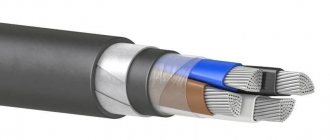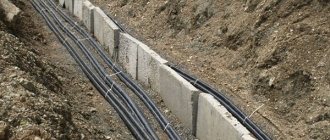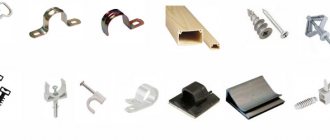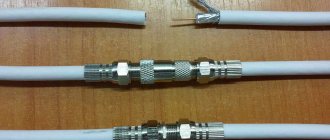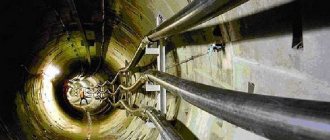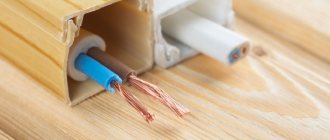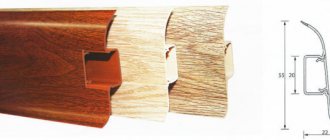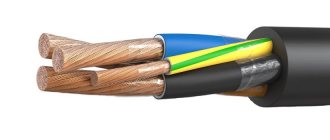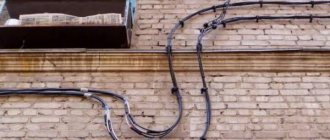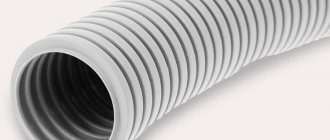Negative factors for street wiring
Cable lines laid outdoors are subject to several negative factors:
- Ultra-violet rays. Sunlight has a detrimental effect on some types of conductor insulation. This process is long and difficult to control. Therefore, you should choose products with insulation made from materials that do not deteriorate when exposed to UV rays.
- Ambient temperature. Low temperatures can lead to cracking of the insulation. Therefore, when choosing cables and wires, you should find out their operating temperature range. The installation temperature should also be taken into account. Usually it is not lower than 20 degrees below zero.
- Wind. Strong winds can damage both the cable line sheath and the conductors inside. If the cable is laid outdoors, the climatic area of installation should be taken into account.
- Ice. If the external network is installed in areas where there is increased ice formation in winter, it is worth taking this factor into account. A conductor covered with an ice crust can become several times heavier and break under its own weight over long spans.
There are three ways to lay cables outdoors, and each of them has its own advantages and disadvantages:
- By air. The fastest installation method. Disadvantages of this method: it requires reliable fastening of the cables, the lines are exposed to the negative influences of weather conditions.
- Along the walls of buildings. For this method it is much easier to select the conductor material. Disadvantages: labor-intensive installation, disruption of the appearance of buildings, negative impact on the conductor of ambient temperature and sunlight.
- In the ground. This method allows you to solve many problems. Weather conditions and sunlight have no effect. The appearance of buildings and surrounding areas is not disturbed. The disadvantage is that electrical installation is labor-intensive, in some cases requiring the use of construction equipment to excavate a trench.
External wiring installation options
Experts identify two ways to conduct electricity to a building. Let's look at the general characteristics of each of them.
- The underground option is preferable to use for short reference distances. Its advantage is the absence of contact of wires with air and open space. This eliminates the negative effects of ultraviolet radiation and temperature changes when seasons and weather conditions change. There is also no possibility of mechanical damage to the wiring. But, along with this, the underground method requires a lot of physical effort due to the need to dig a trench under the pipe. As for the depth of the gasket, it is clearly regulated by standards. It is not recommended to arbitrarily change the depth of the foundation underground, as the risk of freezing increases in the winter season.
- The air method requires more installation time. This is due to the need to install support posts along the entire length of the cable. Also, before installation, you should make sure that the wire has a special layer of protection against moisture. The main damage to an overhead cable can be caused by strong winds and sunlight. Thus, prolonged exposure to ultraviolet radiation makes the cable brittle. In case of a short distance from the distribution box to the building, the air installation method is the most optimal.
The cable can enter the building itself in two ways: hidden and open. The last option is the cheapest and does not require additional installation work. However, its negative side is the need to hide the cable in a pipe or corrugation. This slightly distorts the appearance of the room.
The advantages of this method are the speed of installation and accessibility of the cable. So, in the event of a breakdown or malfunction, it is enough to open the corrugation and diagnose the wiring.
The open installation method is chosen mainly for the street or for utility rooms.
If there is a need to install lighting outdoors, it is preferable to use underground installation. Experts also choose this method for supplying electricity to a bathhouse or barn.
The underground cable is protected from unexpected breaks.
But it is worth paying special attention to the presence of additional insulation from moisture and mechanical damage. It is worth noting that the service life of underground cables exceeds that of overhead wiring.
During repair work, the location of the cable underground must be clearly documented. This is necessary to prevent accidental damage in the future. You can also use columns for marking.
This will be useful in case of redevelopment of the site or if it is necessary to relocate the cable line.
Cable laying over the air
While laying cables indoors usually does not cause problems for installers, laying cables between buildings over the air is usually more labor-intensive.
Communications between houses can be laid in two main ways: underground and by air. Each of these methods has its pros and cons. This article describes a method for laying cable over the air. The advantages of this method include the ease of installation (compared to the installation of underground communications); it is not always possible to lay underground communications; the length of the cable connecting houses is much longer than in the case of an air connection. Disadvantages of laying by air include exposure of air communications to static electricity and lightning discharges, severe weather conditions, which can lead to premature failure of the cable, in case of damage to the outer insulation of the cable due to friction of the cable in contact with other objects, or the occurrence of cracks Due to weather conditions, the cable picks up moisture and causes equipment failure (in this case, only replacing the cable can help). Let's consider connecting two houses by air. Hereinafter, we will agree to call such a connection an air connection.
In the figure: 1 – houses being connected, 2 – cable, 3 – information cable (twisted pair). This is a fairly rough outline of what should happen as a result. So, if you use twisted pair without a cable inside, then the use of a cable is simply necessary (wind, stuck wet snow, ice create enormous loads, the twisted pair cable is not designed for them). It is best to use insulated steel wire as a cable. The cross-section of such a cable with a reasonable air length (less than 80 m) is sufficient to be 1 - 1.5 mm2. Insulation is necessary to prevent corrosion, which can literally “gnaw through” a steel cable of such a small cross-section in just a year. It is necessary to attach the cable to the house to something durable (iron fittings, masts of other cables, etc.). Here the next nuance appears. It is necessary to prevent the steel cable from touching the metal fittings on both houses at the same time. Houses have different potentials, and therefore current will flow through the cable, producing interference on the twisted pair cable, and some other unpleasant consequences are possible. The cable must be grounded. Of course the cable needs to be grounded. It is possible on the one hand. But this will not be the best option, a much better option would be to ground the cable on both sides, but you must either ground it on one side through a container (hard on the other), or break the supporting cable in the middle using a dielectric (for example, from a PCB plate).
Now about the twisted pair cable. In our latitudes, a cable located in the open air finds itself in very difficult conditions. The cable stretched between houses is in particularly difficult conditions. Therefore, I recommend using twisted pair cable with special insulation for the external laying for the air. Ideally, such a cable will be filled with a compound (hydrophobic). The use of shielded cables, in my opinion, is inappropriate. A screen will not prevent the accumulation of static electricity in a cable, but cables with a screen are much more expensive. In order to save equipment connected to the air from discharges of static electricity and thunderstorms, it is necessary to use special devices, so-called lightning protection.
So let's get back to the air lining. The twisted pair cable must be attached to the cable in advance. Any non-conducting material that is not exposed to water and weather conditions can be used as fastening elements. It is most advisable to use nylon ties. Using nylon ties (or other devices), the twisted pair cable is attached to the cable, and it is recommended to fasten the cable and cable with ties every 50-70 cm. It is necessary to control that the cable sag slightly, otherwise it will turn out that the cable is also held by the cable. But at the same time, it is necessary to reduce the sagging to a minimum (in Fig. 1 there is a very large sagging, made solely for the clarity of the figure). It is necessary to tighten the ties firmly, excluding any sliding of the cable relative to the cable, but it is necessary to avoid damaging the cable by very tightly tightening the fastening element (it is necessary that the contact surface of the fastening element is flat and the width of the element is at least 5-7 mm).
Cable laying by air
Laying cables by air involves the use of cable supports, parapet racks (rack-mount supports or masts) installed on the roofs of buildings, as well as various types of open cable structures (overpasses, galleries, etc.).
Cable laying by air on supports and masts
The overhead cable is laid along supports/masts/racks using a separate supporting element (cable) or without it. The load-bearing element is not used for cables of the VSG, APvP-1T, TPPept and similar types, since it is already present in their design (in the case of the APvP-1T cable, a multi-wire steel cable).
Supports, racks and masts can have different designs, which depend on the type of cable products being laid, climatic conditions in the region, and any special requirements for the cable system (for example, fire safety).
apply to overhead power cable wiring when using separate load-bearing elements :
• The cable is fastened to supports/masts/racks using anchor clamps or other types of fastening fittings. The metal components of the cable line are grounded. • The sag of the supporting element after cable installation should be within 1/40 ... 1/60 of the span length (distance between supports). • Fastening the cable to the cable is carried out using plastic or metal hangers mounted along the entire length of the cable every 50–100 cm. • All metal components of the line (cable, fastening fittings, etc.), regardless of the presence of galvanic coating, are treated with lubricant (for example, solid oil) for protection against corrosion.
The requirements for laying communication cables along supports/masts/racks are approximately the same as in the case of power cables. Load-bearing elements can also be used here. There are communication cables with a steel cable in the structure (for example, KSPZPt), which do not require the use of load-bearing elements. It is worth noting that laying an overhead line with a communication cable is permissible provided the cable product capacity is up to 100 pairs. In this case, cables with a capacity of up to 30 pairs can be laid along racks and masts located on the roofs of buildings and structures.
Aerial cable routing via open cable support systems
“Open” refers to cable structures (overpasses, galleries, etc.) installed in the open air. When laying cables over open cable support systems, the following points are taken into account:
• Device for protection against direct contact with solar radiation. Necessary if the external cable protection hose is not designed for use in direct sunlight. Canopies or cable-supporting structures with a cover can be used as protection. • Laying an overhead line with a cable without armor must be carried out using additional structural elements that will protect the conductors from mechanical damage. • Cables with an aluminum or lead sheath require the use of an elastic lining (for example, rubber or PVC) in places of rigid fastening (at route turns, at end joints, couplings, etc.). • Cables are laid with a certain (1–2%) margin in length. To do this, they are laid in a cable-supporting structure like a “snake”.
see also
Comments 45
I buried 16m in metal plastic. for 2 bayonets, next to the path, so that no one would dig. 5 years so far no problems.
I have 3 meters from the bathhouse to the toilet. The electrical panel in the bathhouse. Consider running a cable along the bathhouse and hanging it from the bathhouse to the toilet on a metal cable. VVG wire 3 by 2.5 in a polypropylene corrugation. It’s been hanging like this for 3 years, everything is fine. Withstood the snow winter and rainy summer.
Along the fence, in the corrugation. And don’t say that there is no fence made of prof. Liszt.
The cross-section is at least 2.5 mm. The cable (wire) is better, of course, non-flammable. Provide a distribution box for the input machine and 2 outgoing lines (heating element and sockets). If external installation is possible, then use polypropylene as an option. I liked working with them. There are plenty of fittings, the prices are cheap. The track is sealed and there is always the possibility of crashing into it. Transitions, if required, are carried out on a cable in a metal corrugation. I refused to lay it in the ground. Digging deep (in terms of freezing level) is simply too lazy. And the water may be too close, and since it’s summer with constant rains, the cable will lie in the swamp.
In HDPE corrugated with a double wall at a depth of 50cm. Cable 3x2.5 num or vvgng. If there is no land, then to connect the boiler and pan you will have to weld a triangle or buy a ready-made solution. I do this for myself. Double-wall corrugated HDPE, 3x4 VVGNG cable (available), entry through the floor through a rigid pipe, switchboard with automatic switches, 3x2.5 sockets, 3x2.5 boiler and 1.5 light. THOSE. 4 modules input 25A, sockets, boiler 16A light 10A. Boxing, sockets, switches, IP 65 lamps in the workshop and shower, a simple lamp in the toilet. The walls are laid in HDPE rigid pipes.
One machine gun is enough for him) he’ll take him to the toilet, put the box there and throw it in front of the light, sockets, and switch) why bother so much...
I’m so bothered by the fact that my utility room is combined with a toilet and shower. In the utility room you drill, then saw, or do whatever else)
One machine gun is enough for him) he’ll take him to the toilet, put the box there and throw it in front of the light, sockets, and switch) why bother so much...
It is better to turn off the shower heater when bathing. And this means a separate machine.
He wrote in the topic through the outlet...
This is through the outlet for now. The tank itself is heated. The season was poking, and then I got tired of it. Moreover, the contacts begin to heat up, after all, it is better to make 2.5 kW in a reliable way, and not through a lousy plug-socket. I doubt that he will install expensive and high-quality ones, much less hermetic ones. I would like to connect my tank over time via a time relay. That I didn’t think about it at all and didn’t forget to turn it on.
This is all nonsense) you dig a trench about knee deep, there is a cable there and that’s it) A 3x2.5 cable is better, in a HDPE pipe.
What does better mean? Either in a pipe or armored.
People here write to pull the sip) for light and a couple of sockets and a heating element for the toilet) a 3x2.5 cable can withstand up to 5 kW) a simple black plastic HDPE pipe and that’s all)
You don’t understand, if there is no pipe then the cable must be armored. And it doesn’t matter, at least let the PVS pull
By air or underground: how to supply electricity to a country house?
Every summer resident, when landscaping a country house, is faced with the question of supplying electricity: by air or underground? Which is more durable, cost-effective and aesthetically pleasing? All the pros and cons of each method in our article.
In most cases, in holiday villages, electrification from the transformer substation to the pole near the house is carried out by air. And here the owner of the house does not choose - how the electricians make the line will not be the same. But entry into the house and wiring around the site is the choice exclusively of the owner of the country house. In this article we will talk about the pros and cons of each installation method.
What to remember when laying cable over the air
Any professional installer can handle the installation of electrical wiring indoors, but laying cables over the air almost always causes certain problems and difficulties.
There are two main methods that allow communications between buildings - by air and underground. In each case there are certain advantages and disadvantages.
- less labor-intensive work;
- in comparison with underground communications, it is almost always possible to lay a cable over the air;
- shorter cable length.
- poor resistance to static electricity and lightning discharge;
- the need for high strength and resistance to severe weather conditions;
- the likelihood of timely failure, which may be due to friction against other objects or cracking due to moisture accumulation.
However, there are special recommendations for the selection of materials, installation and operation technologies that make it possible to eliminate all of the listed disadvantages.
Laying wire through the air
This is the most popular and seemingly simple way to bring electricity into the house. There are advantages and disadvantages of this method of organizing input.
Advantages of an overhead line:
- Installation speed . Tensioning the bushing from the support to the insulators on the house takes no more than 40 minutes. In this case, the overhead line, which powers other houses on the street, will be turned off for no more than 10 minutes (it is necessary to connect the phase and neutral wires to the line), so the neighbors will not have time to express dissatisfaction due to the lack of light.
- Easy to maintain . The wire itself does not require maintenance unless it breaks due to a fallen tree or ice. If this happens, its repair will take relatively little time. Please note that it may be necessary to clean and tighten the contacts on the wire from time to time if the connection is made with regular twisting and not with piercing insulators (nuts).
- Relatively cheap . On average, 1 m of 4x16 SIP wire costs 60 - 70 rubles. For input, assuming a distance from the support to the wall of the house of 10 m, you will need about 13 m of wire (additional 3 m for installation in the panel and reserve in case of repair), which will be approximately 900 - 1000 rubles plus 1000 rubles for the installer to hook up the wire for a support, about 2000 rubles . This is several times cheaper than laying a cable, which costs on average 120 rubles per 1 m (AVBbShv cable).
Disadvantages of an overhead line:
- Exposure to environmental factors . Unlike a cable in the ground, an “overhead” wire is exposed to ultraviolet radiation, which affects the condition of the insulation, wind loads, lightning, icing and falling trees, which simply tear the wires. If it breaks from a support or at a connection near the house, then it’s no big deal, as it can be quickly repaired without twists. And if the wire breaks in the middle of the span, then in order to avoid voltage losses due to twists, the entire wire will have to be replaced, and this is an additional considerable expense.
- Obtaining permission to install a support . This may be required if the distance from the support closest to you to the entrance to the house is more than 25 m. Then, in order to avoid sagging of the wire, you will need to install an additional support, the installation of which on average costs 15,000 - 20,000 rubles, depending on the region of residence and the distance of the installation organization from yours country house. Connecting the overhead line to the house is carried out according to the following scheme:
- Lack of aesthetics. For many owners of country houses, the aesthetics of the electrical network is a key factor. Hanging wires spoil the appearance, while a buried cable is nowhere to be seen.
- They can be a nuisance in the yard. Many owners additionally route wires through the air, connecting a shed, workshop or garage. If you have large-sized agricultural machinery, then there is a possibility of breaking the wires by snagging them. In this case, you will have to route the wires in armored sleeves along the fence or walls, or lay the cable underground.
Cable for outdoor installation over the air
SIP wire
This is a self-supporting aluminum wire with insulation made of cross-linked polyethylene. But there are also models characterized by a steel core located inside aluminum. The main area of application for SIP wires is overhead power lines. Laying is possible through the air without the use of corrugation due to the fact that the conductor has insulation that is resistant to ultraviolet radiation.
Installation of SIP wires is carried out using accessories: various clamps, guy wires, as well as insulating boxes. And in order to connect this wire to the copper input into a residential building, it is necessary to use a bolted connection. Installation is possible by air or on walls outside buildings. But when installing on the wall, it is necessary to use non-flammable corrugation.
Advantages of SIP:
- is resistant to ultraviolet radiation;
- does not require additional suspension or the use of cables;
- characterized by durable insulation.
Among the disadvantages of this wire, it is worth highlighting only the need to use corrugated cables when installing on the wall outside the building and the fire hazard. Laying SIP inside buildings is strictly prohibited.
PVS wire
This is a connecting wire characterized by the presence of vinyl insulation and a stranded copper core. In this case, the cores can be from 2 to 5. This type of product is used as an extension cord for gardening equipment, power tools, and so on. Due to its high flexibility, this cable is ideal for connecting to a lawn mower. But this wire is not suitable for creating a wiring network, since its service life does not exceed 6 years.
Advantages of PVS wire:
- is resistant to bending, as it is highly flexible;
- has a thick insulating shell.
The disadvantage of this wire is its short service life, as well as its limited scope of application.
VVG cable
This is a universal cable for outdoor installation over the air. This cable has vinyl core insulation, the same sheath and has no armor. The cable cores, which can be from 2 to 5, are copper, but can also be aluminum. Today there are many modifications of cables of this group. There are models that do not support combustion and are characterized by low smoke emissions, including toxic ones.
Laying VVG cables
possible on a cable, outside buildings, as well as in the ground. But the peculiarity of this conductor is the need for additional protection, namely: a metal hose or corrugated pipe.
If the cable is installed over the air using a corrugated pipe, then it is necessary to use blue or black HDPE corrugation made of polyamide. You can also use a metal hose if the cable needs to be routed along the facade of a building. Laying the conductor in the ground should also be accompanied by the use of protective corrugation - a rigid corrugated HDPE pipe.
The main advantage of the VVG cable is its wide range of applications. This is the most popular cable for outdoor over-the-air installation. It also lasts a long time with the necessary protection. If the VVG cable has a steel cable, then the letter C is added to its marking. The VVGS cable is used mainly in hangars for aerial laying, but indoors.
Cable VBBShv
This is a copper cable having from 1 to 5 cores, vinyl insulation and armor without a cushion. This cable can be used for outdoor installation in the ground without the use of protection. You can also install it on the wall of a building using trays. Protective pipes can be used when laying cables under the road. The main advantages of the VBBShV cable
it could be considered:
- no mandatory requirement for additional protection;
- high strength characteristics, that is, resistance to mechanical stress.
But this cable also has some disadvantages. For example, it is quite inconvenient to install, as it is heavy. In addition, the armor needs to be grounded.
Thus, you can use the following cable for outdoor installation over the air:
- VVG and its modifications (needs protection);
- SIP (laying without the use of a cable is allowed);
- VBBShv (can be laid without additional protection);
- PVA and other types of wires that act as extension cords.
What to consider when laying cables outdoors:
- any conductor operated outdoors needs protection from ultraviolet radiation, so it must have a special protective sheath;
- the cable insulation should not be destroyed under the influence of low or high outdoor temperatures;
- If installation is carried out in a climatic region characterized by periodic ice conditions, it is worth taking into account that the weight of the cable may increase significantly as a result of icing.
Today, there are not only cables for outdoor installation over the air, but also for installation in the ground or along walls outside buildings. The choice of conductor type depends on the installation method and the scope of its application.
Laying cables in the ground
Laying cables, like overhead power lines, has its pros and cons.
Pros of a cable line:
- Aesthetics . Laying cables allows you to avoid unnecessary wires and at the same time beautifully landscape the territory of your home.
Reliability and durability. If all technological processes are followed, including correct connection of the cable to the overhead line on the pole, installation in a PVC pipe and protection of the cable from moisture, the cable can serve its owner without repair or revision for up to 30 - 40 years. It is also not afraid of external environmental factors, since it is buried in the ground.
- Cost-effective when the support distance is large from the house . Although on average the cost of a cable is more expensive than an overhead wire, however, if the overhead line is far from the house, you will not have to obtain permission to install an additional support and pay money for it. Digging a trench and laying cables in this case will cost much less, and you can do it yourself, without resorting to the services of installers (except for connecting the panel to the support).
Disadvantages of a cable line:
- Danger of theft . Unfortunately, in Russia, hunters for non-ferrous metals have not yet been canceled. The cable coming down from the support is visible to the naked eye, so the section from the support to the fence can be dug up and stolen. Of course, this does not happen all the time, but there have been cases.
- Obtaining permission to dig if there are underground communications nearby. If a gas or water pipe is buried near your house, then you will need to invite a representative of Gorgaz or Vodokanal to coordinate the digging of a trench. This takes additional time and you will have to pay for the visit of a representative of the relevant service.
- Laying time. Digging a trench, laying a pipe and pulling a cable along it takes many times longer than stretching the input with a self-supporting insulated wire.
- Total cost of installed cable. If the overhead line does not require additional support, then laying the cable line will cost more. If it is necessary to lay the same 13 m of AVBbShv 4x16 cable (for clarity, we take it as for an overhead line) in a plastic corrugated pipe with a diameter of 110 mm (costs on average 100 rubles per 1 m), provided that you dig a trench yourself, then the cost of installation will be: (13 *120) + (13*100) = 2860 rub.
It is worth considering that you will need to pay the installer about another 1000 rubles for connecting the cable in the panel (or on the support). The total cost will be about 4,000 rubles , which is more expensive than pulling an overhead line.
Difficulty of repair. If a breakdown occurs in the cable somewhere in the middle (not at the inputs), then you will have to dig out the entire buried structure, which takes a lot of time and creates a lot of problems (especially in winter). Also, no objects can be built in the cable laying areas - again for reasons of future repairs.- The need to draw up a drawing . Since the cable line is not visible to the eye, it is necessary to draw up a detailed drawing so that in 20 - 30 years, when your children or grandchildren live in the house (or you sell it), no one accidentally stumbles upon the cable when they dig a trench under the foundation extension or garage. Also, a drawing is needed for repairs so that you know where to dig.
Conclusions: should you choose an overhead or cable line?
An air line is suitable for you if:
An underground cable line is suitable for you if:
- The appearance of your site is important to you.
- In your area, there are strong winds and wires often break due to falling trees.
- You have large-sized agricultural equipment, and you need to power several buildings in your yard.
- The power line support is located more than 25 m from your home, and you do not want to spend money on installing an additional support.
